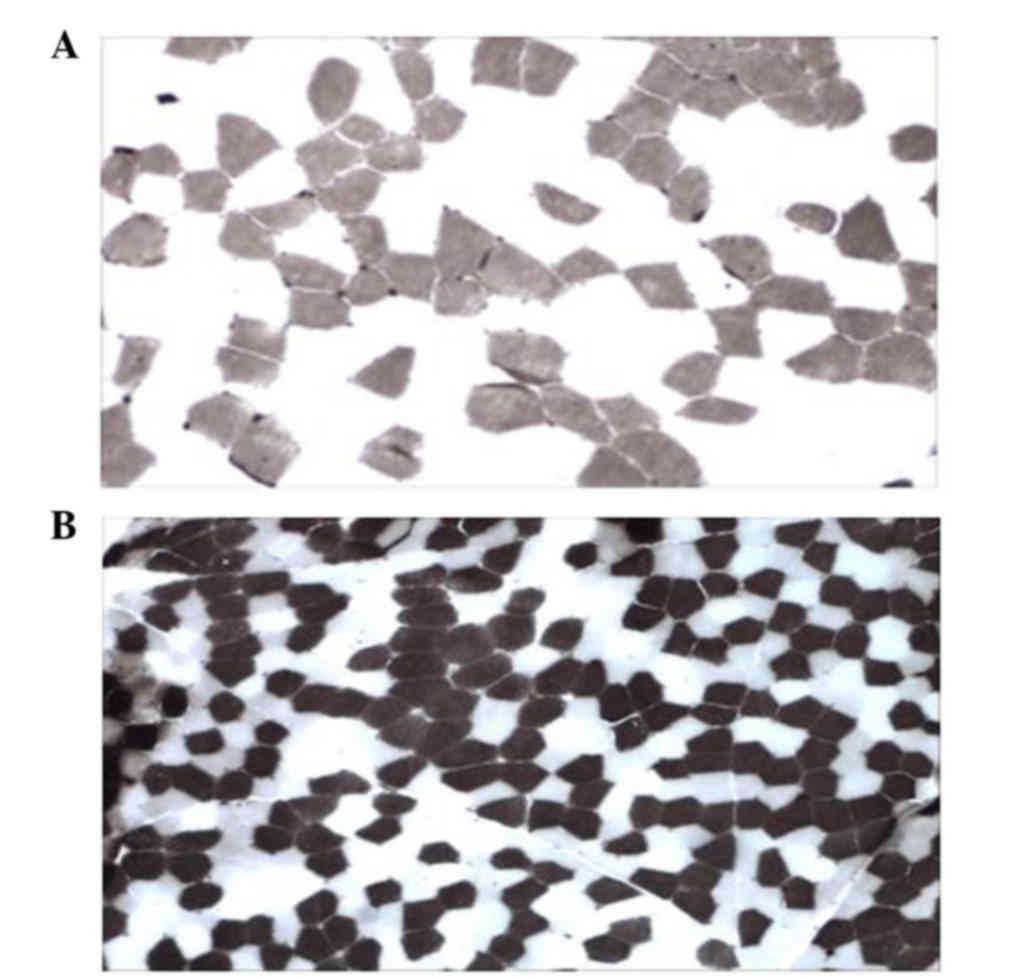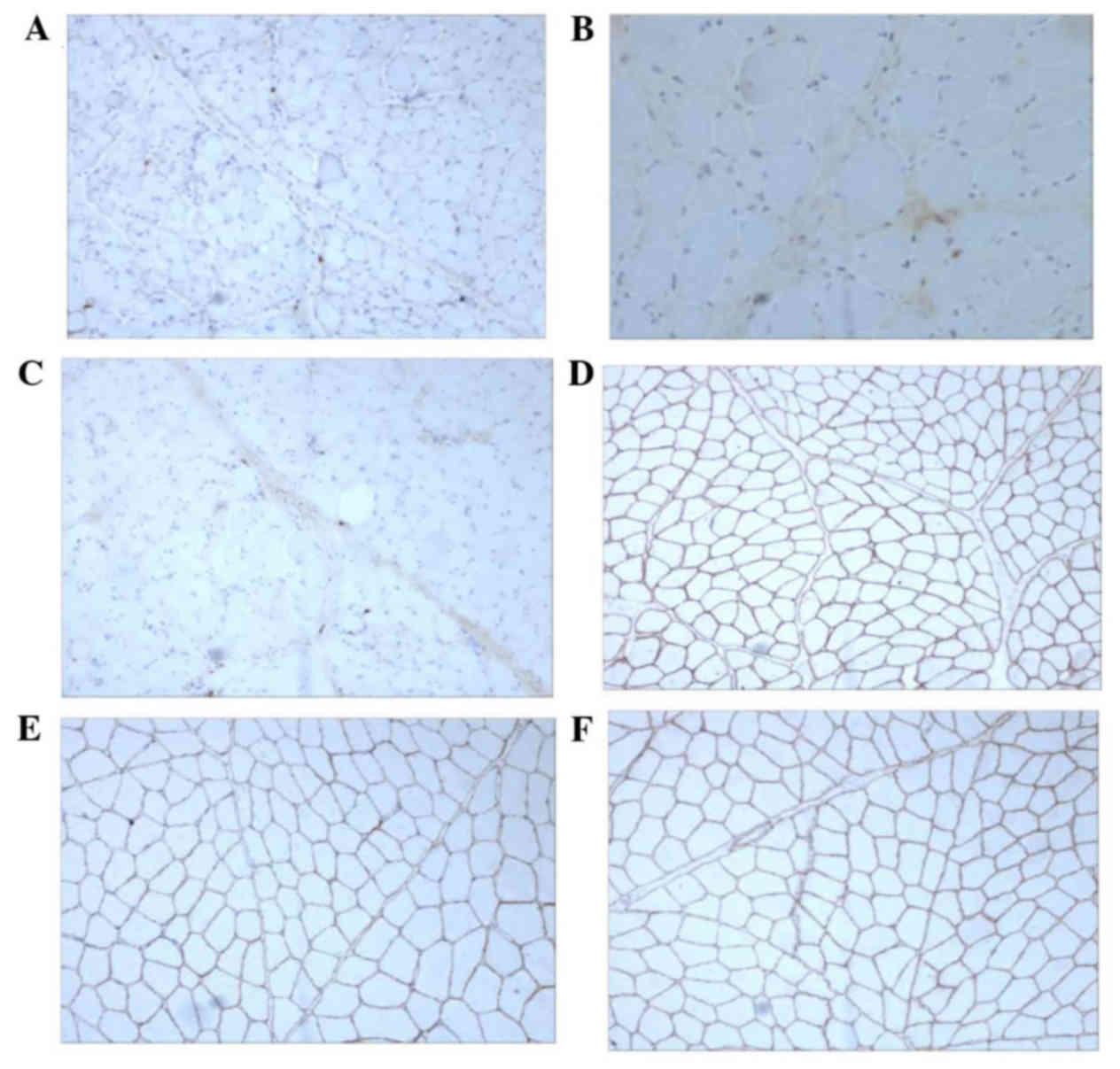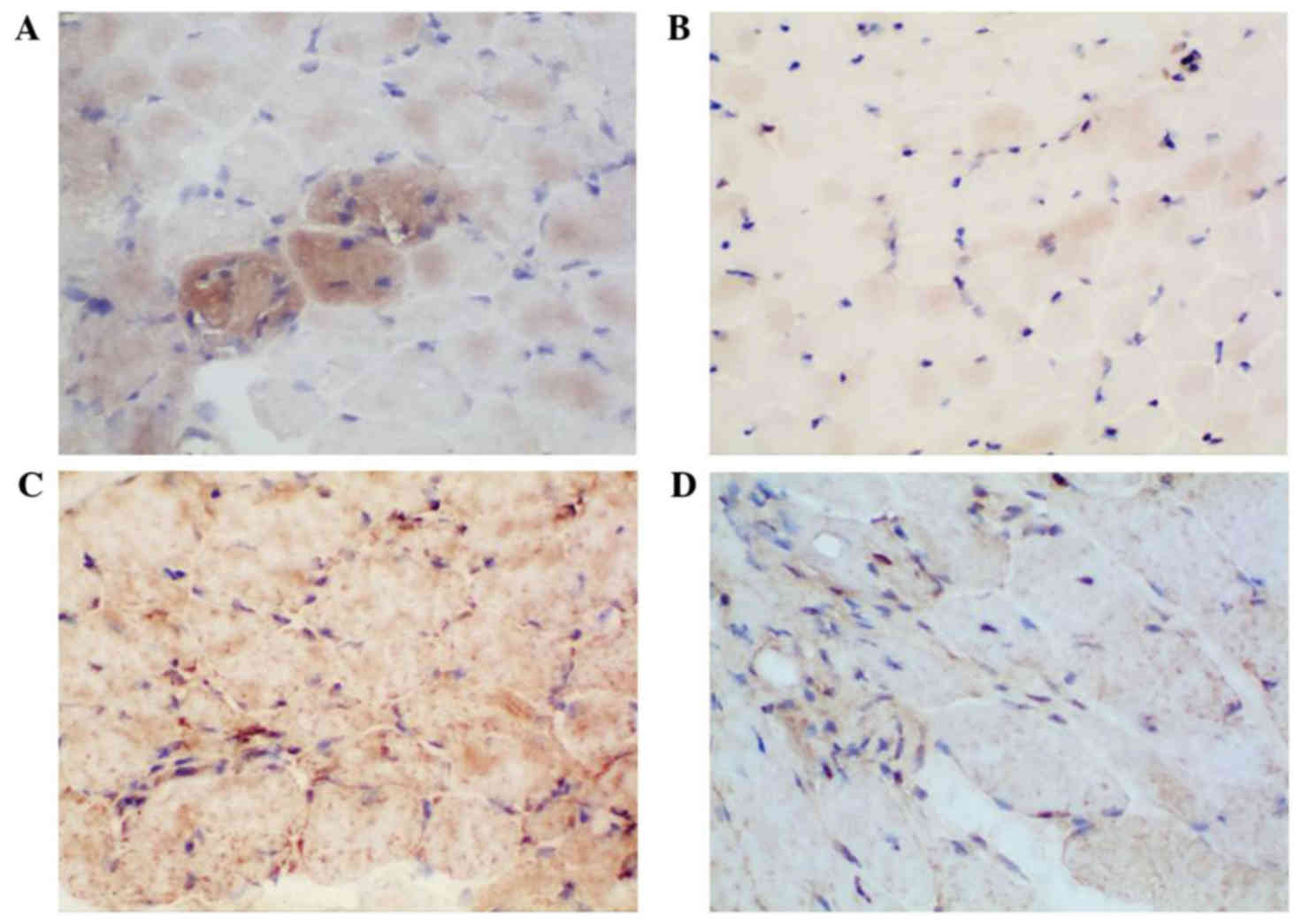|
1
|
Emery AE: Population frequencies of
inherited neuromuscular diseases - a world survey. Neuromuscul
Disord. 1:19–29. 1991. View Article : Google Scholar : PubMed/NCBI
|
|
2
|
Deconinck N and Dan B: Pathophysiology of
duchenne muscular dystrophy: Current hypotheses. Pediatr Neurol.
36:1–7. 2007. View Article : Google Scholar : PubMed/NCBI
|
|
3
|
Worton RG: Duchenne muscular dystrophy:
Gene and gene product; mechanism of mutation in the gene. J Inherit
Metab Dis. 15:539–550. 1992. View Article : Google Scholar : PubMed/NCBI
|
|
4
|
Pessina P, Cabrera D, Morales MG, Riquelme
CA, Gutiérrez J, Serrano AL, Brandan E and Muñoz-Cánoves P: Novel
and optimized strategies for inducing fibrosis in vivo: Focus on
duchenne muscular dystrophy. Skelet Muscle. 4:72014. View Article : Google Scholar : PubMed/NCBI
|
|
5
|
Gibertini S, Zanotti S, Savadori P, Curcio
M, Saredi S, Salerno F, Andreetta F, Bernasconi P, Mantegazza R and
Mora M: Fibrosis and inflammation are greater in muscles of
beta-sarcoglycan-null mouse than mdx mouse. Cell Tissue Res.
356:427–443. 2014. View Article : Google Scholar : PubMed/NCBI
|
|
6
|
Zhou L and Lu H: Targeting fibrosis in
Duchenne muscular dystrophy. J Neuropathol Exp Neurol. 69:771–776.
2010. View Article : Google Scholar : PubMed/NCBI
|
|
7
|
Rifkin DB, Kojima S, Abe M and Harpel JG:
TGF-beta: Structure, function, and formation. Thromb Haemost.
70:177–179. 1993.PubMed/NCBI
|
|
8
|
Samarakoon R, Overstreet JM and Higgins
PJ: TGF-β signaling in tissue fibrosis: Redox controls, target
genes and therapeutic opportunities. Cell Signal. 25:264–268. 2013.
View Article : Google Scholar : PubMed/NCBI
|
|
9
|
Moses HL, Arteaga CL, Alexandrow MG,
Dagnino L, Kawabata M, Pierce DF Jr and Serra R: TGF beta
regulation of cell proliferation. Princess Takamatsu Symp.
24:250–263. 1994.PubMed/NCBI
|
|
10
|
Wenner CE and Yan S: Biphasic role of
TGF-beta1 in signal transduction and crosstalk. J Cell Physiol.
196:42–50. 2003. View Article : Google Scholar : PubMed/NCBI
|
|
11
|
Luft FC: CCN2, the connective tissue
growth factor. J Mol Med (Berl). 86:1–3. 2008. View Article : Google Scholar : PubMed/NCBI
|
|
12
|
Kanaan RA, Aldwaik M and Al-Hanbali OA:
The role of connective tissue growth factor in skeletal growth and
development. Med Sci Monit. 12:RA277–RA281. 2006.PubMed/NCBI
|
|
13
|
Leask A and Abraham DJ: The role of
connective tissue growth factor, a multifunctional matricellular
protein, in fibroblast biology. Biochem Cell Biol. 81:355–363.
2003. View
Article : Google Scholar : PubMed/NCBI
|
|
14
|
Grotendorst GR: Connective tissue growth
factor: A mediator of TGF-beta action on fibroblasts. Cytokine
Growth Factor Rev. 8:171–179. 1997. View Article : Google Scholar : PubMed/NCBI
|
|
15
|
de Winter P, Leoni P and Abraham D:
Connective tissue growth factor: Structure-function relationships
of a mosaic, multifunctional protein. Growth Factors. 26:80–91.
2008. View Article : Google Scholar : PubMed/NCBI
|
|
16
|
Shi-Wen X, Leask A and Abraham D:
Regulation and function of connective tissue growth factor/CCN2 in
tissue repair, scarring and fibrosis. Cytokine Growth Factor Rev.
19:133–144. 2008. View Article : Google Scholar : PubMed/NCBI
|
|
17
|
Bernasconi P, Di Blasi C, Mora M, Morandi
L, Galbiati S, Confalonieri P, Cornelio F and Mantegazza R:
Transforming growth factor-beta1 and fibrosis in congenital
muscular dystrophies. Neuromuscul Disord. 9:28–33. 1999. View Article : Google Scholar : PubMed/NCBI
|
|
18
|
Sun G, Haginoya K, Wu Y, Chiba Y,
Nakanishi T, Onuma A, Sato Y, Takigawa M, Iinuma K and Tsuchiya S:
Connective tissue growth factor is overexpressed in muscles of
human muscular dystrophy. J Neurol Sci. 267:48–56. 2008. View Article : Google Scholar : PubMed/NCBI
|
|
19
|
Vial C, Zúñiga LM, Cabello-Verrugio C,
Cañón P, Fadic R and Brandan E: Skeletal muscle cells express the
profibrotic cytokine connective tissue growth factor (CTGF/CCN2),
which induces their dedifferentiation. J Cell Physiol. 215:410–421.
2008. View Article : Google Scholar : PubMed/NCBI
|
|
20
|
Morales MG, Cabello-Verrugio C, Santander
C, Cabrera D, Goldschmeding R and Brandan E: CTGF/CCN-2
over-expression can directly induce features of skeletal muscle
dystrophy. J Pathol. 225:490–501. 2011. View Article : Google Scholar : PubMed/NCBI
|
|
21
|
Andreetta F, Bernasconi P, Baggi F, Ferro
P, Oliva L, Arnoldi E, Cornelio F, Mantegazza R and Confalonieri P:
Immunomodulation of TGF-beta 1 in mdx mouse inhibits connective
tissue proliferation in diaphragm but increases inflammatory
response: Implications for antifibrotic therapy. J Neuroimmunol.
175:77–86. 2006. View Article : Google Scholar : PubMed/NCBI
|
|
22
|
Taniguti AP, Pertille A, Matsumura CY,
Neto H Santo and Marques MJ: Prevention of muscle fibrosis and
myonecrosis in mdx mice by suramin, a TGF-β1 blocker. Muscle Nerve.
43:82–87. 2011. View Article : Google Scholar : PubMed/NCBI
|
|
23
|
Morales MG, Gutierrez J, Cabello-Verrugio
C, Cabrera D, Lipson KE, Goldschmeding R and Brandan E: Reducing
CTGF/CCN2 slows down mdx muscle dystrophy and improves cell
therapy. Hum Mol Genet. 22:4938–4951. 2013. View Article : Google Scholar : PubMed/NCBI
|
|
24
|
Miranda AF, Bonilla E, Martucci G, Moraes
CT, Hays AP and Dimauro S: Immunocytochemical study of dystrophin
in muscle cultures from patients with Duchenne muscular dystrophy
and unaffected control patients. Am J Pathol. 132:410–416.
1988.PubMed/NCBI
|
|
25
|
Momma K, Noguchi S, Malicdan MC, Hayashi
YK, Minami N, Kamakura K, Nonaka I and Nishino I: Rimmed vacuoles
in Becker muscular dystrophy have similar features with inclusion
myopathies. PLoS One. 7:e520022012. View Article : Google Scholar : PubMed/NCBI
|
|
26
|
Fan Z, Wang J, Ahn M, Shiloh-Malawsky Y,
Chahin N, Elmore S, Bagnell CR Jr, Wilber K, An H, Lin W, et al:
Characteristics of magnetic resonance imaging biomarkers in a
natural history study of golden retriever muscular dystrophy.
Neuromuscul Disord. 24:178–191. 2014. View Article : Google Scholar : PubMed/NCBI
|
|
27
|
Confalonieri P, Oliva L, Andreetta F,
Lorenzoni R, Dassi P, Mariani E, Morandi L, Mora M, Cornelio F and
Mantegazza R: Muscle inflammation and MHC class I up-regulation in
muscular dystrophy with lack of dysferlin: An immunopathological
study. J Neuroimmunol. 142:130–136. 2003. View Article : Google Scholar : PubMed/NCBI
|
|
28
|
Wahab NA, Yevdokimova N, Weston BS,
Roberts T, Li XJ, Brinkman H and Mason RM: Role of connective
tissue growth factor in the pathogenesis of diabetic nephropathy.
Biochem J. 359:77–87. 2001. View Article : Google Scholar : PubMed/NCBI
|
|
29
|
Sun G, Haginoya K, Dai H, Chiba Y, Uematsu
M, Hino-Fukuyo N, Onuma A, Iinuma K and Tsuchiya S: Intramuscular
renin-angiotensin system is activated in human muscular dystrophy.
J Neurol Sci. 280:40–48. 2009. View Article : Google Scholar : PubMed/NCBI
|
|
30
|
Mezzano V, Cabrera D, Vial C and Brandan
E: Constitutively activated dystrophic muscle fibroblasts show a
paradoxical response to TGF-beta and CTGF/CCN2. J Cell Commun
Signal. 1:205–217. 2007. View Article : Google Scholar : PubMed/NCBI
|
|
31
|
Werneck LC, Scola RH, Maegawa GH and
Werneck MC: Comparative analysis of PCR-deletion detection and
immunohistochemistry in Brazilian Duchenne and Becker muscular
dystrophy patients. Am J Med Genet. 103:115–120. 2001. View Article : Google Scholar : PubMed/NCBI
|
|
32
|
Zuo QH: Nervous system disorders in
children. 2nd. Beijing: People's Medical Publishing House, Beijing;
2002
|
|
33
|
Li Y, Foster W, Deasy BM, Chan Y, Prisk V,
Tang Y, Cummins J and Huard J: Transforming growth factor-beta1
induces the differentiation of myogenic cells into fibrotic cells
in injured skeletal muscle: A key event in muscle fibrogenesis. Am
J Pathol. 164:1007–1019. 2004. View Article : Google Scholar : PubMed/NCBI
|
|
34
|
Wang JC, Sonnylal S, Arnett FC, De
Crombrugghe B and Zhou X: Attenuation of expression of
extracellular matrix genes with siRNAs to Sparc and Ctgf in skin
fibroblasts of CTGF transgenic mice. Int J Immunopathol Pharmacol.
24:595–601. 2011. View Article : Google Scholar : PubMed/NCBI
|
|
35
|
Falke LL, Dendooven A, Leeuwis JW, Nguyen
TQ, van Geest RJ, van der Giezen DM, Broekhuizen R, Lyons K, Stoop
R, Kemperman H, et al: Hemizygous deletion of CTGF/CCN2 does not
suffice to prevent fibrosis of the severely injured kidney. Matrix
Biol. 31:421–431. 2012. View Article : Google Scholar : PubMed/NCBI
|
|
36
|
Tzeng JI, Chen MF, Chung HH and Cheng JT:
Silymarin decreases connective tissue growth factor to improve
liver fibrosis in rats treated with carbon tetrachloride. Phytother
Res. 27:1023–1028. 2013. View
Article : Google Scholar : PubMed/NCBI
|
|
37
|
Ambrosio F, Ferrari RJ, Distefano G,
Plassmeyer JM, Carvell GE, Deasy BM, Boninger ML, Fitzgerald GK and
Huard J: The synergistic effect of treadmill running on stem-cell
transplantation to heal injured skeletal muscle. Tissue Eng Part A.
16:839–849. 2010. View Article : Google Scholar : PubMed/NCBI
|
|
38
|
Black SA Jr, Palamakumbura AH, Stan M and
Trackman PC: Tissue-specific mechanisms for CCN2/CTGF persistence
in fibrotic gingiva: Interactions between cAMP and MAPK signaling
pathways, and prostaglandin E2-EP3 receptor mediated activation of
the c-JUN N-terminal kinase. J Biol Chem. 282:15416–15429. 2007.
View Article : Google Scholar : PubMed/NCBI
|
|
39
|
Black SA Jr and Trackman PC: Transforming
growth factor-beta1 (TGFbeta1) stimulates connective tissue growth
factor (CCN2/CTGF) expression in human gingival fibroblasts through
a RhoA-independent, Rac1/Cdc42-dependent mechanism: statins with
forskolin block TGFbeta1-induced CCN2/CTGF expression. J Biol Chem.
283:10835–10847. 2008. View Article : Google Scholar : PubMed/NCBI
|
|
40
|
Tian J, Yang F and Liu H: TGF-Beta and
CTGF mediated signal transduction pathway and fibrosis. Proceedings
of the 2012 international conference on biomedical engineering and
biotechnology. 913–916. 2012. View Article : Google Scholar
|
|
41
|
Frazier K, Williams S, Kothapalli D,
Klapper H and Grotendorst GR: Stimulation of fibroblast cell
growth, matrix production, and granulation tissue formation by
connective tissue growth factor. J Invest Dermatol. 107:404–411.
1996. View Article : Google Scholar : PubMed/NCBI
|












